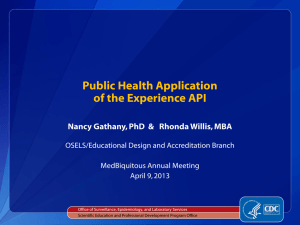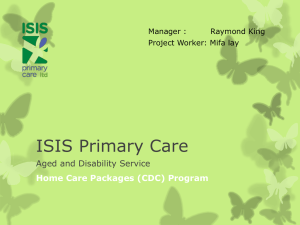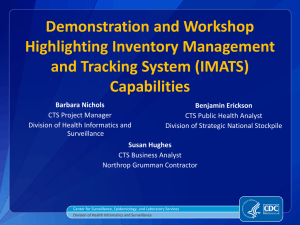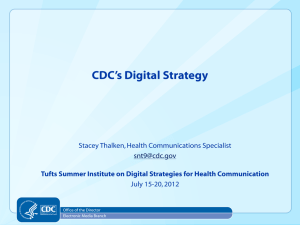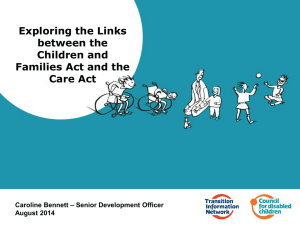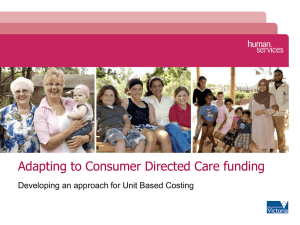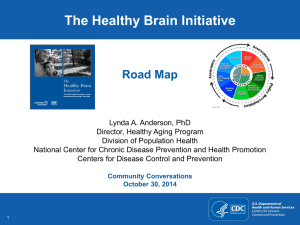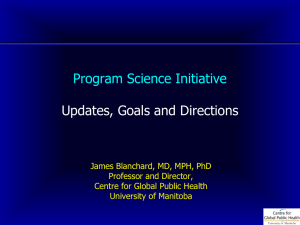Centers for Disease Control and Prevention
advertisement
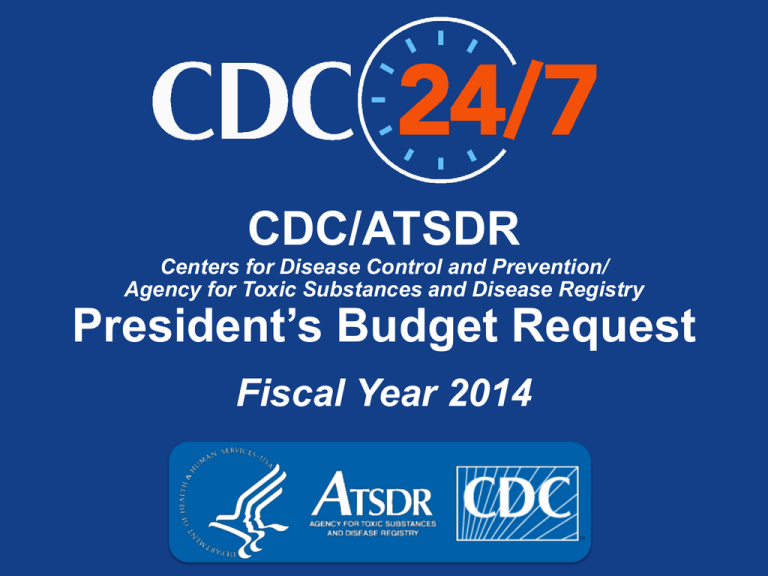
CDC/ATSDR Centers for Disease Control and Prevention/ Agency for Toxic Substances and Disease Registry z President’s Budget Request Fiscal Year 2014 Overview • Overview of CDC • FY 2014 President’s Budget Request • Questions and answers CDC: Our nation’s health protection agency • Founded in 1946 • Part of the U.S. Department of Health and Human Services • Headquartered in Atlanta, Georgia • 10,000+ full-time employees • 70% of funding helps state and local public health departments, others CDC activities • Monitor health • Detect and investigate health problems • Conduct research to enhance prevention • Develop evidence for policies that improve public's health • Promote healthy behaviors and implement prevention strategies • Foster safe and healthful environments • Provide leadership and training Save lives, protect people, save money through prevention • Ready 24 hours a day, 7 days a week to respond to and prepare for infectious diseases, environmental hazards, injuries, and other health threats and emergencies • Analyzes health information and investigates health threats to protect people in the U.S. and around the world • Promotes proven methods to prevent disease, improve health, and lower health costs Putting science into action CDC turns science into real-world solutions and applies science to protect people and improve health Strengthen communities Majority of CDC’s funding goes to state and local public health departments, providing them with resources and support to protect Americans from health threats CDC protects Americans from threats from this country and around the world CDC operates ~150 labs with ~2,500 scientists and other lab staff Infectious diseases (reference, diagnosis, research) Environmental health (genetics, nutrition, chemicals, toxins) Preparedness and response (bioterrorism, outbreaks, disasters) Occupational safety and health (workplace safety) Lab standards and science (quality & regulatory compliance) Global health (HIV, malaria, TB, emerging diseases) CDC lab facilities in the U.S. Morgantown, WV Ft Collins, CO Cincinnati, OH Anchorage, AK Atlanta, GA San Juan, PR Key winnable battles Six areas where public health can have a substantial impact Tobacco HealthcareAssociated Infections Teen Pregnancy Nutrition, Physical Activity, Obesity and Food Safety Motor Vehicle Injuries HIV CDC works to protect us from health, safety, and security threats • Provides real-time response during emergencies • Works with state and local health departments to investigate and control outbreaks • Every day, CDC begins at least one investigation of potentially deadly health threat • On average, CDC discovers one new microbe or new form of an old one each year "CDC is the 9-1-1 for the world.” Ambassador Carson, Assistant Secretary of State for African Affairs CDC tracks food poisoning cases and monitors for outbreaks across the U.S. to help keep us healthy In 2012 CDC • Tracked >30 pathogens known to cause foodborne illness • Monitored an average of 20 clusters of foodborne illness every week • Investigated >200 cases that cross state lines “There are certain things only a government can do. And one of those things is ensuring that the foods we eat are safe and do not cause us harm.” President Obama • Information led to recall of 300 products, such as peanut butter, leafy greens, cantaloupes, sprouts, ground beef, raw scraped ground tuna, mangoes, dry dog food, and ricotta cheese CDC’s disease detectives Epidemic Intelligence Service (EIS) • 2-year program of service and on-the-job training for health professionals interested in practice of epidemiology • Every year, 70–80 people assigned to CDC or state/local health departments • EIS officers conduct epidemiologic investigations, research, and public health surveillance nationally and internationally • 75% of EIS graduates stay in public health at CDC or in state/local health departments www.cdc.gov/eis CDC provides health information CDC publishes scientific journals and educates the public by providing health information so they can make informed decisions about their health, safety, and security CDC staff throughout the world 300+ direct hires in 50+ countries 1,300+ host country national staff 40+ staff detailed to international organizations CDC Global Disease Detection Centers CDC staff GDD regional center CDC global immunization activities CDC staff Global immunization activities CDC global influenza activities CDC staff CDC influenza international CDC malaria assignees CDC staff CDC malaria assignees CDC Field Epidemiology Training Programs CDC staff CDC Field Epidemiology Training Programs CDC and Department of Defense collaborations CDC staff DoD collaboration CDC global AIDS program CDC staff CDC global AIDS program CDC provides assistance throughout the world CDC staff GDD regional center Global immunization CDC influenza international CDC malaria assignees CDC Field Epidemiology Training Program DoD collaboration CDC global AIDS program CDC helps save lives and reduce illness around the world • Protects our borders by stopping epidemics before they spread • Provides stability by preventing diseases that increase poverty and contribute to political unrest in many countries • Promotes economic viability by reducing disruptions in productivity, international trade and markets caused by illnesses and outbreaks • Partners with ministries of health to provide training for health officials, establish health surveillance systems, and adapt effective public health interventions so that countries can protect the health of their citizens • CDC stops epidemics and saves lives around the world • Immunizations • Helped cut measles deaths and saved 10.7M lives worldwide from 2000−2011 • Helped reduce global polio cases from 350,000 to <250 • Haiti response • Cholera response activities helped avert >9,000 deaths • Doubled HIV treatment, increased vaccination rates, introduced new vaccines and treatments – all with local, sustainable leadership • Helped create stronger, sustainable public health and health care systems in Haiti • Lymphatic filariasis • Provided mass drug administration with nearly 2B treatments to 600M people The world is closer than ever to polio eradication www.polioeradication.org Budget proposal for FY 2014 • Builds on FY 2012 investments and administrative savings • Continues separate appropriation structure • Does not consolidate budget lines • Implements Working Capital Fund FY 2012 FY 2014 PB FY 2014 +/– FY 2012 Budget Authority $5,649M $5,217M –$432M PHS Eval Transfer $371M $618M +$246M Prevention Fund $809M $755M –$54M HHS Emergency Fund $30M $0 –$30M $6,859M $6,589M –$270M Total Dollars rounded to nearest million; FY 2012 and 2013 amounts have been made comparable to FY 2014 CDC program level Funding in past 5 years $8,000 FY 2014 Budget Authority $1.2 billion below FY 2010 $7,500 $7,000 $6,500 $6,000 $5,500 $5,000 $4,500 $0 $4,000 FY 2010 Budget Authority FY 2011 PHS Eval Transfer FY 2012* ARRA FY 2014 PB ACA Prevention Fund PHSSEF Dollars in millions; FY 2012 was made comparable to FY 2014; FY 2014 does not reflect the sequester. FY 2014 budget increases Comparison to FY 2012 • Protecting Americans from infectious diseases • Advanced Molecular Detection and response to infectious disease outbreaks (+$40M) • Food safety (+$17M) • Domestic HIV/AIDS prevention and research (+$13M) • National Healthcare Safety Network (+$13M) • Protecting against global threats • Polio eradication (+$15M) FY 2014 budget increases Comparison to FY 2012 (continued) • Preventing the leading causes of disease, disability, and death • National Violent Death Reporting System (+$20M) • Tobacco control (+$14M) • Gun violence prevention research (+$10M) • Million Hearts (+$5M) • Rape prevention and education (+$5M) • Monitoring health • Health statistics (+$22M) • Keeping Americans safe from environmental and work-related hazards • Healthy homes/lead poisoning prevention (+$2M) FY 2014 key budget decreases Comparison to FY 2012 • Community transformation grants (–$80M) • Preventive health and health services block grant (–$80M) • Immunization (–$61M) • Racial and ethnic approaches to community health (–$54M) • Occupational safety and health (–$53M) • Breast and cervical cancer and colorectal screening (–$42M) • Strategic national stockpile (–$38M) • Buildings and facilities (–$10M) • Workplace wellness (–$10M) • State and local preparedness and response capability (–$8M) • Environmental health tracking network (–$6M) • Hospitals promoting breastfeeding (–$5M) • Prevention research centers (–$4M) CDC's ability to effectively respond to infectious disease outbreaks is at risk • CDC currently lacks the cutting-edge analytical capabilities to enable faster and more effective infectious disease prevention and control • CDC labs rely on decade-old methods to detect and diagnose microbes, leading to slower outbreak response • Cholera outbreak in Haiti • PulseNet: Expands the use of molecular technologies to improve food safety • Drug-resistant infections Advanced Molecular Detection combines cutting-edge approaches Traditional epidemiology + Genetic sequencing + Bioinformatics = Advanced Molecular Detection Advanced Molecular Detection saves lives, time, and money • Revolutionizes how CDC investigates and controls outbreaks • Detects disease outbreaks faster, in just hours or days • Better protects Americans from killer microbes • Detects and stops drug resistant, emerging, and important pathogens faster • Protects U.S. economy • U.S. lives and economic stability depend on CDC detecting and responding quickly to superbugs • Creates healthier workforce and stronger economy Improving public health through AMD technologies Advanced Molecular Detection will allow CDC to detect outbreaks sooner, respond more effectively, saving lives and reducing cost IMPROVED DETECTION IMPROVED SURVEILLANCE Faster, more accurate disease diagnoses and enhanced recognition of antimicrobial resistance Improved surveillance information on the transmission of infections and the extent and spread of outbreaks Better targeting of prevention and treatment measures Faster, more effective control efforts Prevent the leading causes of death Prevention Fund successes Community prevention is key to prevent disease and reduce growth in long-term health care and other costs • Tips From Former Smokers campaign 1st-year successes • Projected to result in >100,000 successful quits • >200,000 additional calls to 800-QUIT-Now • Thousands of lives and millions of health care dollars will be saved • Community Transformation Grant recipient have proven successes • South Carolina: 450,000 patients will receive recommended high blood pressure and high cholesterol care • Provided comprehensive workplace health training to employers nationwide, with >2,000 participants • Reached 90% or higher vaccine coverage for measles, mumps, rubella; hepatitis B; poliovirus; and varicella Building essential public health detection and response Prevention Fund successes Critical to stop outbreaks and safeguard communities from natural and man-made threats • Fungal meningitis outbreak: tracked down 14,000 exposed patients; assured removal of contaminated product from facilities; saved lives and solved this urgent threat in concert with local public health authorities • NJ improved efficiency of reporting influenza results and cut lag time from 2–3 weeks to 2–3 days • Listeria: 146 infected in 28 states and 30 deaths; outbreak solved in 2 weeks, rather than in months • Fellows: Supported 320 CDC applied epidemiology and lab trained public health fellows; supported 74% of CDC’s trainees placed in the field Information for action Prevention Fund Successes Strengthen health systems that gather, analyze, and communicate data to produce timely and accurate information for action • Determined financial burden of care, use of Emergency Department for usual care, insurance coverage rates and difficulties obtaining insurance, and barriers to care • NHIS: state-level data will be available for the first-time ever and 80 new ACA-focused questions were added • Massachusetts used BRFSS data to analyze short-term effects of legislation on health insurance coverage to target outreach efforts for health insurance enrollment and health care access FY 2014 key programmatic change Working Capital Fund • Incentivize efficiency and collaboration • Greater efficiency and transparency of business support services • Operates on revenues collected for services; multi-year • Distributes business services support funds across programs’ budget lines • Estimate amounts based on past use of business services • CDC will provide updated information based on consumption • FY 2012 levels made comparable to FY 2014 FY 2014 program level FY11 enacted FY12 enacted* FY14 PB FY14+/FY12 Budget Authority $5,649M $5,649M $5,217M –$432M PHS Eval Transfer $352M $371M $618M +$246M ATSDR $77M $76M $76M $0 HHS Emergency Fund $225M $30M $0M –$30M Prevention Fund $611M $809M $755M –$54M Other User Fees $2M $2M $2M $0 $6,916M $6,937M $6,668 –$270M TOTAL Dollars in millions; pre-sequester *FY 2012 made comparable to FY 2014. For more budget information www.cdc.gov/budget


